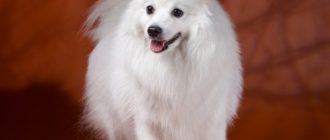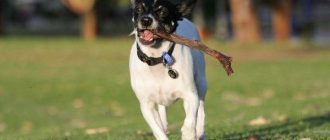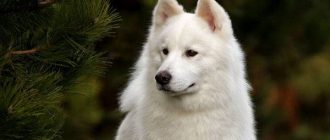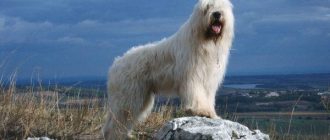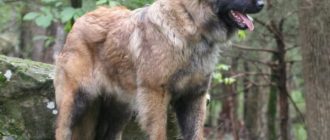Assessment of breed characteristics
Contents
| Adaptability Definition of how easy a dog is. can adapt to changes in life. |  |
| Shedding Level Level and frequency of hair loss in animal. |  |
| Level of tenderness Level and amount of tenderness and affection that the dog gives back in return for attention to itself. |  |
| Need for Exercise Daily Activity Level dogs. |  |
| Social need Required number of dog contacts with other animals as well as people. |  |
| Housing ratio Factor that determines the level of noise and other inconvenience that the dog can deliver to the owners in the ratio the size of the apartment to the size of the dog. |  |
| Grooming Number of bathing, combing, as well as necessary number of professional grooming sessions required the dog. |  |
| Friendliness in an unfamiliar environment society with strangers or in an unfamiliar environment. |  |
| The tendency to bark The tendency to bark and its frequency and volume. |  |
| Health Issues Potential Health Status dogs. |  |
| Territorial tendency of the dog to protect his house, yard or even a car owner. |  |
| Cat friendliness A trend towards cat tolerance and reduced manifestation of hunting instincts. |  |
| Intelligence Dog’s ability to think and solve emerging difficulties (not to be confused with learning!). |  |
| Education and training Level of difficulty in training a dog perform certain actions. |  |
| Friendliness for children Factor determining how much the dog friendly to children, whether she likes to play with them and endure some children’s pranks. |  |
| Game activity The concept is determined by its very name, and, usually found in almost all dogs. |  |
| Observability Dog’s ability to detect presence a stranger in his territory. |  |
| Friendliness for other dogs Dog’s tendency to find common language with other relatives. |  |
Brief description of the breed
Akita Inu is a large and noble breed of dog that originally used to protect the royal family and nobility feudal Japan. Dogs were also used to hunt wild boars, bear and deer. The animal is fearless and insanely loyal to its family. Akita Inu is very difficult to frighten with something, this is the dog that is unlikely whether it deviates from its intended purpose. At the same time, the pet is very funny, Of course, this can only be achieved with training. dogs. Akita Inu has a peculiar appearance: a large head and somewhat small triangular eyes. The dog’s strong body is the main factor that acts intimidatingly on the enemy. Breed known for her unwavering loyalty to the owner, kindness and affection for loved ones. What could be better than having one a strong and loving patron? Dogs of this breed are not prone to barking violently, but at the same time remain quite “vocal”. The thing is that Akita Inu are prone to making various sounds similar to grunts, snorts, moans, etc. Some owners say that they get the impression that the dog is talking to himself, muttering to himself under his breath. Representatives of this amazing breed careful enough to strangers, but if the owner is nearby, then the dog restrained and does not show extraneous aggression or otherwise Attention. Akita Inu loves to carry various things in her teeth. Can get to the point that the pet will grab your wrist slightly and try to drag somewhere. Do not take such a gesture as aggression. This is actually a manifestation of the pet’s attention. Often dogs of this breed hide slippers and personal belongings, can drag leash or, conversely, bring it to you. Thus the animal shows his desire to walk. An unusual feature that relates to dogs, breed Akita Inu, the so-called “cat behavior”. These animals love to lick their body. Also to feline manifestations include the way of hunting. The animal behaves as if tiger. Akita Inu track down prey in silence, keeping body low land, and at the right time attack. Unlike other Akita dogs Inu will not bark or growl. Before purchasing Akita Inu, it’s important to study all the nuances of raising and keeping a dog. These pets are like and other animals that respond poorly to aggression and harsh methods education. The whole learning process should be built on mutual understanding and establishing contact between the pet and the owner. Remember that the dog is a full member of the family who needs love and respect. Be prepared for training and learning. Akita Inu will take longer than with other breeds. Although Akita is a smart enough dog, but somewhat wayward, stubborn character will not go unnoticed. Akita Inu is very sociable and social. They need a lot of communication, therefore, they should spend a lot of time with their family. Exactly communication will become a key in the process of training and training. Not in Do not resort to keeping Akita Inu in the yard. Dog must live with you under one roof! Loneliness for such dogs destructive, the animal will become nervous and aggressive. Akita Inu is not suitable for people who want to have a calm dog, as well for that category of dog breeders who are afraid of serious responsibility. The animal will become a real gift only who is ready to put all their attention and love into education pet, his proper training. Such a master will be generous When choosing a puppy, Akita Inu should decide on her variety. The fact is that there are two standards for this Breeds: American and Japanese. Japanese Akita Inu is much less American, both in height and weight. Japanese weight Species about 15 kg less than the American. Head a Japanese dog resembles a fox head in shape, which is impossible say about the American, which has a larger and wider head. Another distinguishing feature is the eyes. At American variety, they have a triangular shape, and Japanese dogs are more rounded. American akita is the owner of a black mark on the face, Japanese are characterized by white spots. These significant differences have been the subject of debate about official division of the breed. Despite the large number of those who supports the idea of dividing akita inu into two breeds, still this question remains only a matter of much debate. the hunting instincts of Akita Inu have not disappeared over its long history. Now they are manifested in the tendency of dogs to frolic on the water and in the forest. These dogs can chase waterfowl at the same time. time, while the owner is fishing on the shore. Despite the many discussions and disputes, the fact that akita inu is really strong, fearless and faithful a dog with remarkable personality traits and amazing appearance. Akita Inu – very compassionate. Confirmation of this may serve as a case at the London Zoo. When a newborn baby Sumatran tiger was left an orphan, zoo staff began look for possible ways to feed a tiger cub. The choice fell on Akita Inu, who was just feeding puppies. Zoo staff were sure that Akita would not be afraid of such a test, and they did not were mistaken! The dog not only fed the tiger cub, but also played and looked after him. This is a sign of boundless love and tenderness. Akita Inu is a dog for people who are confident in themselves and in own forces, for those who are ready and willing to give their the warmth and attention of our smaller brothers!
Photo Akita Inu:
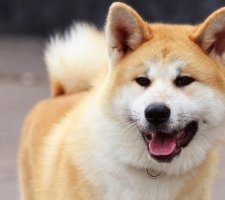
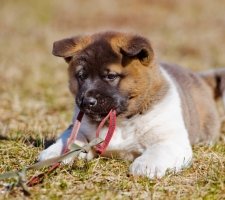
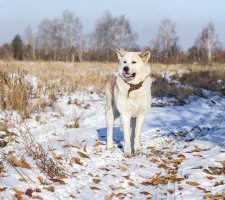
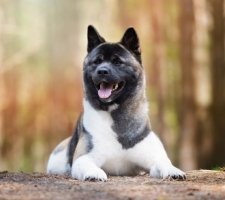
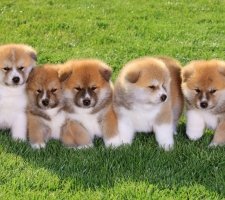
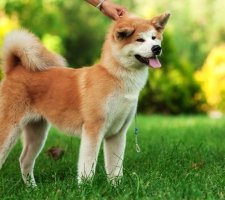


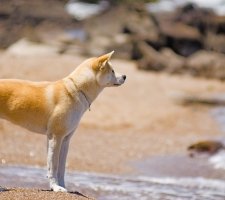 Photo of Akita Inu breed dogs |
Photo of Akita Inu breed dogs |
Origin history
The birthplace of Akita Inu dogs is Japan, or rather the server region Honshu Island (famous for its volcano Fuji – the highest point of the Land of the Rising Sun) – Tohoku. It is in those parts mostly found on the territory of Akita Prefecture ancient dogs similar to modern akita inu. Japanese Inu means “dog”, that is, the name of the breed is a dog from Akita. True, history is silent about who the ancestors of Akita were, because according to According to some reports, the animals are similar in appearance to Japanese inu appeared no later than the 2nd millennium BC. By the way, this the breed is recognized as one of the oldest (like Shiba Inu – the other famous breed from Japan), developed almost without difficulty person. In other words, the pretty appearance of Akita Inu is a gift. nature, and not at all the merit of geneticists and breeders. There is the opinion that the ancestors of today’s Akita Inu appeared as a result of crossbreeding Chinese dogs with local Japanese archipelago. At the time of the beginning of our era, the territory of Japan became massively populated by Chinese and Korean peoples, which in addition to their own simple belongings were transported to a new place of residence and your go (i.e. dogs). Over time, there was a mixing of blood animals imported into Japan with long-lived centuries dogs. Another version of the appearance of Akita Inu is associated with the oldest the Ainu people who inhabited the southern part of the Japanese islands. Already with Jomon period (from about 13000 BC) the Ainu began to experience difficulties in dealing with Asian invaders (from South China and Southeast Asia), who decided to select the fertile soils of the south for growing rice. Ainu always found food in the hunt, fishing and gathering, so compete with resourceful immigrants could not. And so the indigenous people moved closer to north – to the island of Honshu, covered with mountains, volcanoes and thick forests. And he brought with him dogs that helped in the hunt for large the beast – a bear, a wild boar, a deer. But here too the unfortunate Ainu with their dogs were not left alone – gradually invaders we got to the north of Japan, finding out about gold-bearing ores and valuable wood island. Relative peace came only at the end of the XVI centuries when not only the way of the original owners changed Akita Inu – Ainu, but the dogs themselves, crossed with individuals, once brought from Asian countries. In different years, Akita Inu (during the Kinsais period of the 1570s to the 1860s CE) were used as hunting, guard and fighting dogs (took part in dog and bull fights) .In order to enhance anger and give Akita special the mixing of the blood of Japanese dogs with breeds imported from Europe, which negatively affected the original distinctive appearance of the breed, and on their hunting character. TO at the beginning of the 19th century, dog fighting was banned, what made the breed unpopular, therefore, disappearing. Yes and purebred Akita units remained. By 1920, work began breeders aimed at eliminating the metamorphosis that occurred with ancient dogs from promiscuous crossbreeding, was formed Akita Inu Conservation Society. In 1931, Akita Inu were recognized as a national treasure of Japan, and in 1938 the first breed standard. Although Akita still had difficult periods ahead, one of which is World War II. In difficult times during the war, many dogs were exterminated for tailoring uniforms from hides, and meat was used as food. However, already in 1947 the first exhibition, attended by a little over 20 survivors dogs. In Russia, Akita Inu is primarily loved, not even because of unusual exterior, and because of the legends about the loyalty of these dogs (to For example, the film “Hachiko: the most faithful friend” or an ancient legend about Shirou, and the Japanese themselves call the character Akita Inu “innate valor “- a kind of evidence of devotion, courage and love animal to man). They were brought to our country at the beginning XXI century, since then the popularity of Akita Inu has not fallen – founded nurseries, there are more and more willing to get partners a dog from the Land of the Rising Sun.
The character of Akita Inu
Akita Inu dogs were originally bred for protection representatives of the Japanese royal family. Strong and impressive the dog’s body constitution perfectly matches the overall external mind guard dog. Despite the formidable look, Akita Inu is very affectionate and gentle with family members. They are great companions, but the character is distinguished by a certain obstinacy that may become a serious obstacle to training and learning. Representatives of this breed are prone to barking, they often show dominance and perseverance in character. Complex nature akita inu says this dog is not suitable for beginners dog breeders.
Maintenance and care
Akita Inu dogs can have a variety of colors, including black, white, chocolate, brindle. These dogs have thick enough undercoat. Generally take care of the coat Akita Inu is easy, but in Akita Inu dogs it’s easy distributed around the house, including for furniture and clothes, so you will have to quite often vacuum in the apartment. Heavy molt occurs twice a year. During this period, it is especially important weekly comb out the pet to keep its coat healthy and beautiful condition. Despite the fact that Akita Inu are distinguished by their a tendency to self-care, yet bathe the dog due to the peculiarities of her coat, it is necessary three to four times a month. Everything the fact is that representatives of this breed love to run through puddles and wallow in the mud. Ear Care Weekly careful monitoring of the condition of the ear canals and treatment a special solution with a balanced pH level prescribed by the veterinarian. Make sure that there is no irritation in the ears. and inflammation. Claws should be trimmed once a month.
Training and training
Akita Inu is hard to train. This is primarily due to the complex nature of the dog. A coach must have leadership qualities and be confident. Sequence and perseverance – the main components of a correct and successful dog training. Since Akita Inu was bred initially as guard dogs, they are endowed with natural alertness to everything to the unknown. That is why the process of early socialization of puppies of this breed. During the period of socialization, puppies should understand what is dangerous and what is not. The dog should also understand the difference between a guest and an unsolicited stranger.
Health and Disease
Most Akita Inu have these health problems: hip dysplasia, eye disease, including progressive retinal atrophy, which causes blindness, immune disorders, von Willebrand disease, impaired blood coagulation, impaired immune system, which affects on the skin, sebaceous adenoma (a disease that may end death of a pet).

